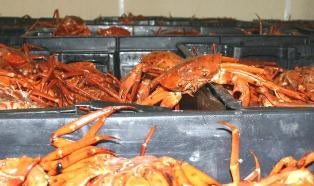My last post on EDFish described a day I spent in the tidal creeks of South Carolina fishing for blue crabs with local waterman Fred Dockery. Today, I’d like to share some valuable insights gleaned from a very different crab fishery.
The deep-sea Atlantic red crab fishery had long escaped the attention of many stakeholders in New England owing to its comparatively small fleet and modest landings relative to larger scale cousins like the sea scallop, groundfish and lobster fisheries. Indeed, the fishery did not even have a management plan until 2002. However, last fall, red crab assumed an unexpected level of attention in response to advice on acceptable biological catch (ABC) from the New England Fishery Management Council’s Scientific and Statistical Committee (SSC, on which I sit) that many deemed to be too low and likely to impose excessive socio-economic hardships.
Fortunately, the months since the September 2009 Council meeting where the SSC first delivered its red crab ABC saw scientists, managers and the industry take the steps needed to generate better catch advice. Efforts made to generate better catch advice were consistent with sound scientific and fishery management process, thus turning a tense controversy into a valuable example of how to do things better.
Industry and SSC members worked directly with the red crab Plan Development Team to expand and clarify the science underpinning the ABC. Also, fellow committee member Dr. Dan Georgianna and I visited the red crab unloading and processing facility in New Bedford just before the March 2010 SSC meeting at which we revisited the red crab ABC. Our visit aimed to help us learn more about the fishery and its operations to better inform our advice to the Council on both immediate issues and others that might arise down the track, and to help the industry better understand SSC operations and rationale. The result of those scientific and outreach efforts was an improved analysis and better understanding that gave the SSC more confidence in setting a higher catch limit for 2010 and beyond.
Beyond its constructive participation in the management process, the red crab fishery illustrates the value of cooperative research and innovative business planning in building a more robust and sustainable business model, one that could be enhanced by conversion to catch shares. We discuss the red crab fishery and its future potential in more detail in the newest edition of CSC – Red Crab Dec 2010 from the EDF Catch Share Design Center.










